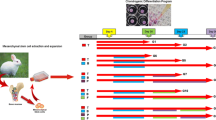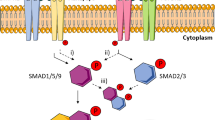Abstract
Purpose
Mesenchymal stem cells (MSCs) express markers of hypertrophic chondrocytes during chondrogenic differentiation. We tested the suitability of parathyroid hormone-related protein (PTHrP), a regulator of chondrocyte hypertrophy in embryonic cartilage development, for the suppression of hypertrophy in an in vitro hypertrophy model of chondrifying MSCs.
Methods
Chondrogenesis was induced in human MSCs in pellet culture for two weeks and for an additional two weeks cultures were either maintained in standard chondrogenic medium or transferred to a hypertrophy-enhancing medium. PTHrP(1–40) was added to the medium throughout the culture period at concentrations from 1 to 1,000 pM. Pellets were harvested on days one, 14 and 28 for biochemical and histological analysis.
Results
Hypertrophic medium clearly enhanced the hypertrophic phenotype, with increased cell size, and strong alkaline phosphatase (ALP) and type X collagen staining. In chondrogenic medium, 1–100 pM PTHrP(1–40) did not inhibit chondrogenic differentiation, whereas 1,000 pM PTHrP(1–40) significantly reduced chondrogenesis. ALP activity was dose-dependently reduced by PTHrP(1–40) at 10–1,000 pM in chondrogenic conditions. Under hypertrophy-enhancing conditions, PTHrP(1–40) did not inhibit the induction of the hypertrophy. At the highest concentration (1,000 pM) in the hypertrophic group, aggregates were partially dedifferentiated and differentiated areas of these aggregates maintained their hypertrophic appearance.
Conclusions
PTHrP(1–40) treatment dose-dependently reduced ALP expression in MSC pellets cultured under standard chondrogenic conditions and is thus beneficial for the maintenance of the chondrogenic phenotype in this medium condition. When cultured under hypertrophy-enhancing conditions, PTHrP(1–40) could not diminish the induced enhancement of hypertrophy in the MSC pellets.






Similar content being viewed by others
References
Johnstone B, Hering TM, Caplan AI, Goldberg VM, Yoo JU (1998) In vitro chondrogenesis of bone marrow-derived mesenchymal progenitor cells. Exp Cell Res 238(1):265–272
Yoo JU, Barthel TS, Nishimura K, Solchaga L, Caplan AI, Goldberg VM, Johnstone B (1998) The chondrogenic potential of human bone-marrow-derived mesenchymal progenitor cells. J Bone Joint Surg Am 80(12):1745–1757
Mueller MB, Blunk T, Appel B, Maschke A, Goepferich A, Zellner J, Englert C, Prantl L, Kujat R, Nerlich M, Angele P (2013) Insulin is essential for in vitro chondrogenesis of mesenchymal progenitor cells and influences chondrogenesis in a dose-dependent manner. Int Orthop 37(1):153–158
Sekiya I, Vuoristo JT, Larson BL, Prockop DJ (2002) In vitro cartilage formation by human adult stem cells from bone marrow stroma defines the sequence of cellular and molecular events during chondrogenesis. Proc Natl Acad Sci U S A 99(7):4397–4402
Mueller MB, Tuan RS (2008) Functional characterization of hypertrophy in chondrogenesis of human mesenchymal stem cells. Arthritis Rheum 58(5):1377–1388
Mueller MB, Fischer M, Zellner J, Berner A, Dienstknecht T, Prantl L, Kujat R, Nerlich M, Tuan RS, Angele P (2010) Hypertrophy in mesenchymal stem cell chondrogenesis: effect of TGF-beta isoforms and chondrogenic conditioning. Cells Tissues Organs 192(3):158–166
Mackay AM, Beck SC, Murphy JM, Barry FP, Chichester CO, Pittenger MF (1998) Chondrogenic differentiation of cultured human mesenchymal stem cells from marrow. Tissue Eng 4(4):415–428
Goldring MB, Tsuchimochi K, Ijiri K (2006) The control of chondrogenesis. J Cell Biochem 97(1):33–44
Shimizu H, Yokoyama S, Asahara H (2007) Growth and differentiation of the developing limb bud from the perspective of chondrogenesis. Dev Growth Differ 49(6):449–454
Pelttari K, Winter A, Steck E, Goetzke K, Hennig T, Ochs BG, Aigner T, Richter W (2006) Premature induction of hypertrophy during in vitro chondrogenesis of human mesenchymal stem cells correlates with calcification and vascular invasion after ectopic transplantation in SCID mice. Arthritis Rheum 54(10):3254–3266
Guo J, Chung UI, Yang D, Karsenty G, Bringhurst FR, Kronenberg HM (2006) PTH/PTHrP receptor delays chondrocyte hypertrophy via both Runx2-dependent and -independent pathways. Dev Biol 292(1):116–128
Kronenberg HM (2006) PTHrP and skeletal development. Ann N Y Acad Sci 1068:1–13
Weisser J, Riemer S, Schmidl M, Suva LJ, Pöschl E, Bräuer R, von der Mark K (2002) Four distinct chondrocyte populations in the fetal bovine growth plate: highest expression levels of PTH/PTHrP receptor, Indian hedgehog, and MMP-13 in hypertrophic chondrocytes and their suppression by PTH (1–34) and PTHrP (1–40). Exp Cell Res 279(1):1–13
Weiss S, Hennig T, Bock R, Steck E, Richter W (2010) Impact of growth factors and PTHrP on early and late chondrogenic differentiation of human mesenchymal stem cells. J Cell Physiol 223(1):84–93
Li TF, Dong Y, Ionescu AM, Rosier RN, Zuscik MJ, Schwarz EM, O’Keefe RJ, Drissi H (2004) Parathyroid hormone-related peptide (PTHrP) inhibits Runx2 expression through the PKA signaling pathway. Exp Cell Res 299(1):128–136
Ducy P, Zhang R, Geoffroy V, Ridall AL, Karsenty G (1997) Osf2/Cbfa1: a transcriptional activator of osteoblast differentiation. Cell 89(5):747–754
Enomoto H, Enomoto-Iwamoto M, Iwamoto M, Nomura S, Himeno M, Kitamura Y, Kishimoto T, Komori T (2000) Cbfa1 is a positive regulatory factor in chondrocyte maturation. J Biol Chem 275(12):8695–8702
Komori T, Yagi H, Nomura S, Yamaguchi A, Sasaki K, Deguchi K, Shimizu Y, Bronson RT, Gao YH, Inada M, Sato M, Okamoto R, Kitamura Y, Yoshiki S, Kishimoto T (1997) Targeted disruption of Cbfa1 results in a complete lack of bone formation owing to maturational arrest of osteoblasts. Cell 89(5):755–764
Canalis E, Economides AN, Gazzerro E (2003) Bone morphogenetic proteins, their antagonists, and the skeleton. Endocr Rev 24(2):218–235
Kronenberg HM (2003) Developmental regulation of the growth plate. Nature 423(6937):332–336
Mello MA, Tuan RS (2006) Effects of TGF-beta1 and triiodothyronine on cartilage maturation: in vitro analysis using long-term high-density micromass cultures of chick embryonic limb mesenchymal cells. J Orthop Res 24(11):2095–2105
Okubo Y, Reddi AH (2003) Thyroxine downregulates Sox9 and promotes chondrocyte hypertrophy. Biochem Biophys Res Commun 306(1):186–190
Quarto R, Campanile G, Cancedda R, Dozin B (1997) Modulation of commitment, proliferation, and differentiation of chondrogenic cells in defined culture medium. Endocrinology 138(11):4966–4976
Ballock RT, O’Keefe RJ (2003) The biology of the growth plate. J Bone Joint Surg Am 85-A(4):715–726
Leboy PS, Sullivan TA, Nooreyazdan M, Venezian RA (1997) Rapid chondrocyte maturation by serum-free culture with BMP-2 and ascorbic acid. J Cell Biochem 66(3):394–403
Ballock RT, Heydemann A, Wakefield LM, Flanders KC, Roberts AB, Sporn MB (1993) TGF-beta 1 prevents hypertrophy of epiphyseal chondrocytes: regulation of gene expression for cartilage matrix proteins and metalloproteases. Dev Biol 158(2):414–429
Acknowledgments
Supported by AO Research Fund (S-07-3M), DFG (MU-2318/1) and the Intramural Research Program of NIAMS, NIH (AR Z01 41131).
Author information
Authors and Affiliations
Corresponding author
Rights and permissions
About this article
Cite this article
Mueller, M.B., Fischer, M., Zellner, J. et al. Effect of parathyroid hormone-related protein in an in vitro hypertrophy model for mesenchymal stem cell chondrogenesis. International Orthopaedics (SICOT) 37, 945–951 (2013). https://doi.org/10.1007/s00264-013-1800-1
Received:
Accepted:
Published:
Issue Date:
DOI: https://doi.org/10.1007/s00264-013-1800-1




